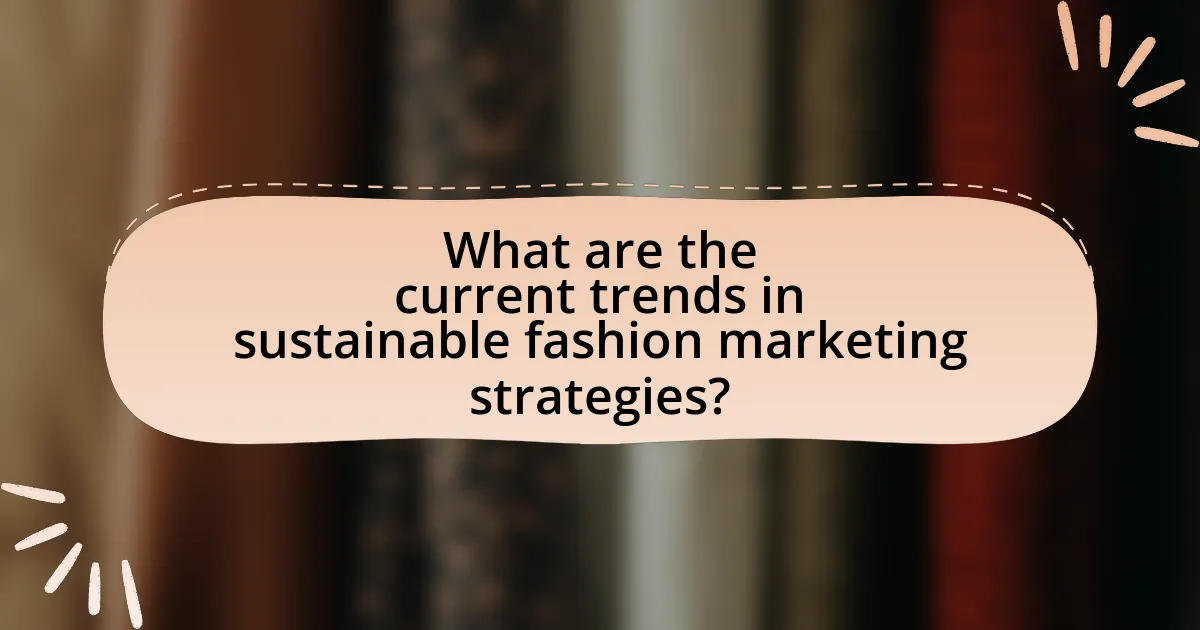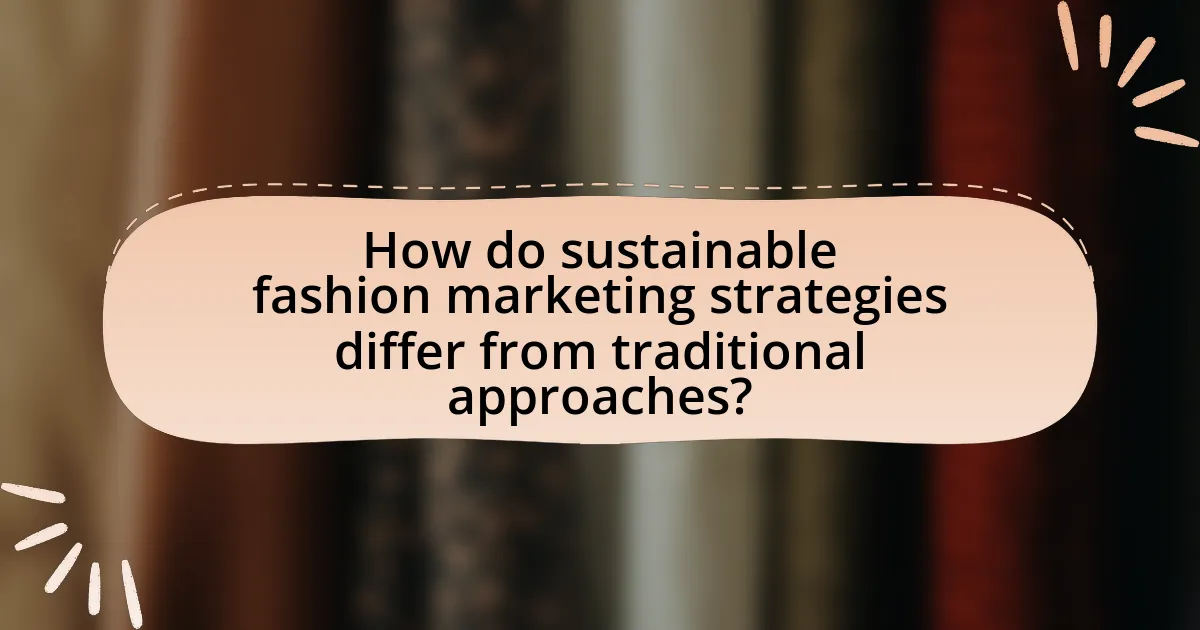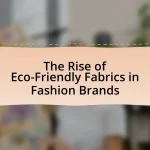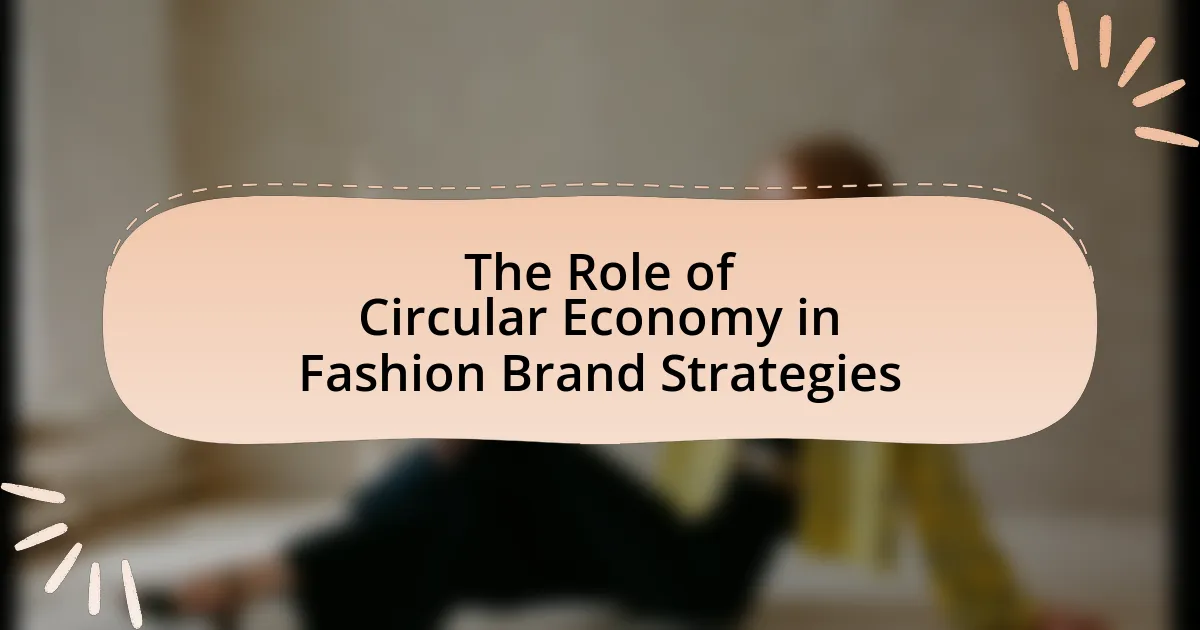The article focuses on current trends in sustainable fashion marketing strategies, highlighting the importance of storytelling, transparency in supply chains, and the promotion of circular fashion. It discusses how brands are adapting to consumer demand for sustainability by integrating eco-friendly practices and utilizing effective marketing channels, particularly social media. The article also examines the influence of storytelling on consumer perceptions, the role of influencers, and the challenges brands face, such as consumer skepticism and high production costs. Additionally, it outlines best practices for effective communication of sustainability efforts and explores future directions for sustainable fashion marketing, emphasizing the need for transparency and the use of emerging technologies.

What are the current trends in sustainable fashion marketing strategies?
Current trends in sustainable fashion marketing strategies include the use of storytelling, transparency in supply chains, and the promotion of circular fashion. Brands are increasingly leveraging storytelling to connect emotionally with consumers, highlighting their sustainable practices and the impact of their products. Transparency in supply chains is becoming essential, as consumers demand to know the origins of materials and the ethical practices involved in production. Additionally, the promotion of circular fashion, which emphasizes recycling and upcycling, is gaining traction, with brands encouraging consumers to participate in sustainable practices through take-back programs and repair services. These strategies are supported by research indicating that 66% of consumers are willing to pay more for sustainable brands, demonstrating a growing market for eco-conscious fashion.
How are brands adapting to consumer demand for sustainability?
Brands are adapting to consumer demand for sustainability by integrating eco-friendly practices into their operations and product offerings. Many companies are now using sustainable materials, such as organic cotton and recycled polyester, to reduce their environmental impact. For instance, brands like Patagonia and H&M have committed to using 100% sustainable cotton by 2025 and increasing the use of recycled materials in their products. Additionally, brands are enhancing transparency in their supply chains, allowing consumers to trace the origins of their products, which builds trust and aligns with consumer values. According to a 2021 McKinsey report, 67% of consumers consider sustainability when making purchasing decisions, prompting brands to prioritize sustainable practices to meet this growing demand.
What marketing channels are most effective for promoting sustainable fashion?
Social media platforms, particularly Instagram and TikTok, are the most effective marketing channels for promoting sustainable fashion. These platforms allow brands to visually showcase their eco-friendly products and engage with a younger, environmentally conscious audience. According to a 2021 report by McKinsey & Company, 67% of consumers consider sustainability when making a purchase, and social media significantly influences their decisions. Additionally, influencer partnerships on these channels can amplify brand messages, as influencers often have established trust with their followers, leading to higher engagement rates and conversions.
How do storytelling and brand narratives influence consumer perceptions?
Storytelling and brand narratives significantly influence consumer perceptions by creating emotional connections and enhancing brand identity. When brands utilize storytelling, they convey their values, mission, and the impact of their products, which resonates with consumers on a personal level. For instance, a study by the Harvard Business Review found that emotionally connected customers are more than twice as valuable as highly satisfied customers, indicating that narratives that evoke emotions can lead to stronger brand loyalty and preference. Additionally, effective brand narratives can differentiate a brand in a crowded market, particularly in sustainable fashion, where consumers increasingly seek authenticity and transparency. This connection fosters trust and can lead to increased consumer engagement and advocacy, ultimately shaping their purchasing decisions.
What role does social media play in sustainable fashion marketing?
Social media plays a crucial role in sustainable fashion marketing by providing a platform for brands to engage directly with consumers and promote their eco-friendly practices. This engagement fosters community building and awareness around sustainability issues, allowing brands to share their values and initiatives effectively. For instance, a study by the Global Fashion Agenda found that 62% of consumers prefer brands that are transparent about their sustainability efforts, highlighting the importance of social media in communicating these messages. Additionally, social media enables brands to showcase their sustainable products visually, which can enhance consumer interest and drive purchasing decisions.
Which platforms are most impactful for sustainable fashion brands?
Social media platforms, particularly Instagram, Pinterest, and TikTok, are the most impactful for sustainable fashion brands. These platforms enable brands to visually showcase their eco-friendly products and connect with a target audience that values sustainability. For instance, Instagram’s emphasis on visual content allows brands to share compelling stories about their sustainable practices, while TikTok’s viral nature can amplify brand messages quickly. According to a 2021 report by McKinsey & Company, 67% of consumers consider sustainability when making a purchase, highlighting the importance of these platforms in reaching environmentally conscious consumers.
How can influencers enhance the visibility of sustainable fashion initiatives?
Influencers can enhance the visibility of sustainable fashion initiatives by leveraging their large followings to promote eco-friendly brands and practices. They create engaging content that highlights the benefits of sustainable fashion, such as reduced environmental impact and ethical production methods. For instance, a study by the University of Southern California found that influencer marketing can increase brand awareness by up to 11 times, demonstrating the effectiveness of influencers in reaching wider audiences. By collaborating with sustainable brands, influencers can authentically share their values and encourage their followers to adopt more sustainable fashion choices, thereby amplifying the message and impact of these initiatives.
What are the challenges faced by brands in sustainable fashion marketing?
Brands in sustainable fashion marketing face several challenges, including consumer skepticism, high production costs, and limited market reach. Consumer skepticism arises from doubts about the authenticity of sustainability claims, as studies show that 66% of consumers are concerned about greenwashing, where brands exaggerate their eco-friendly practices. High production costs are another significant barrier, as sustainable materials and ethical labor practices often lead to higher prices, making it difficult for brands to compete with fast fashion. Additionally, limited market reach can hinder brand visibility, as sustainable fashion often appeals to a niche audience, restricting broader consumer engagement. These challenges collectively impact the effectiveness of marketing strategies in the sustainable fashion sector.
How do misconceptions about sustainability affect marketing efforts?
Misconceptions about sustainability significantly hinder marketing efforts by creating confusion among consumers regarding what constitutes sustainable practices. When brands promote misleading or vague sustainability claims, they risk alienating environmentally conscious consumers who seek transparency and authenticity. For instance, a study by the Nielsen Global Sustainability Report found that 66% of consumers are willing to pay more for sustainable brands, but only if they trust the brand’s claims. This indicates that misconceptions can lead to skepticism, reducing the effectiveness of marketing campaigns aimed at promoting sustainable products. Furthermore, brands that fail to align their marketing messages with genuine sustainable practices may face backlash, resulting in negative publicity and loss of customer loyalty.
What are the barriers to consumer engagement in sustainable fashion?
Barriers to consumer engagement in sustainable fashion include high costs, lack of awareness, and limited availability of sustainable options. High costs deter consumers as sustainable products often come with a premium price tag, making them less accessible to budget-conscious shoppers. Lack of awareness stems from insufficient marketing and education about the benefits of sustainable fashion, leading to consumer indifference. Limited availability refers to the scarcity of sustainable options in mainstream retail, which restricts consumer choice and convenience. According to a 2021 survey by McKinsey & Company, 66% of consumers expressed a willingness to pay more for sustainable brands, yet only 27% reported finding enough sustainable options in their local markets, highlighting the disconnect between consumer interest and product availability.

How do sustainable fashion marketing strategies differ from traditional approaches?
Sustainable fashion marketing strategies prioritize environmental and social responsibility, contrasting with traditional approaches that often emphasize profit maximization and consumerism. Sustainable strategies focus on transparency, ethical sourcing, and storytelling that highlights the ecological impact of products, while traditional marketing typically relies on mass advertising and trends without addressing sustainability. For instance, brands like Patagonia utilize their marketing to promote environmental activism and responsible consumption, which resonates with a growing consumer base that values sustainability, as evidenced by a 2021 survey indicating that 66% of global consumers are willing to pay more for sustainable brands. This shift reflects a broader trend where sustainable fashion brands engage in community-building and education, fostering loyalty through shared values rather than just transactional relationships.
What unique messaging is used in sustainable fashion marketing?
Sustainable fashion marketing utilizes unique messaging that emphasizes environmental responsibility, ethical production, and social impact. This messaging often highlights the use of eco-friendly materials, fair labor practices, and the reduction of waste, appealing to consumers’ growing awareness of sustainability issues. For instance, brands may communicate their commitment to reducing carbon footprints or promoting circular fashion, where products are designed for longevity and recyclability. Research indicates that 66% of global consumers are willing to pay more for sustainable brands, demonstrating the effectiveness of this messaging in influencing purchasing decisions.
How does transparency impact consumer trust in sustainable brands?
Transparency significantly enhances consumer trust in sustainable brands. When brands openly share information about their sourcing, production processes, and environmental impact, consumers are more likely to perceive them as credible and trustworthy. A study by the Nielsen Global Corporate Sustainability Report found that 66% of consumers are willing to pay more for sustainable brands, indicating that transparency directly correlates with consumer willingness to support these brands financially. Furthermore, brands that provide clear, accessible information about their sustainability practices foster a sense of accountability, which strengthens consumer loyalty and trust.
What are the key differences in target demographics between sustainable and traditional fashion marketing?
Sustainable fashion marketing primarily targets environmentally conscious consumers, often younger demographics such as Millennials and Gen Z, who prioritize ethical consumption and sustainability. In contrast, traditional fashion marketing typically appeals to a broader audience, including older generations, focusing on trends, brand prestige, and affordability. Research indicates that 73% of Millennials are willing to pay more for sustainable products, highlighting their significant role in the sustainable fashion market. Additionally, a study by McKinsey & Company shows that 67% of Gen Z consumers consider sustainability when making purchasing decisions, further emphasizing the demographic shift towards sustainability in fashion.
How do collaborations and partnerships enhance sustainable fashion marketing?
Collaborations and partnerships enhance sustainable fashion marketing by leveraging shared resources and audiences to amplify brand visibility and credibility. When sustainable fashion brands collaborate with established companies or influencers, they can reach a broader audience that values sustainability, thus increasing consumer engagement. For instance, partnerships with eco-conscious influencers can lead to a 10-20% increase in brand awareness, as these influencers often have dedicated followings that trust their recommendations. Additionally, collaborations can lead to innovative product offerings that combine sustainability with unique design, attracting consumers who prioritize both aesthetics and ethical practices. This strategic alignment not only strengthens brand positioning but also fosters a community around sustainable practices, ultimately driving sales and promoting a more sustainable fashion industry.
What types of partnerships are most effective in promoting sustainability?
Collaborative partnerships between brands, NGOs, and governmental organizations are most effective in promoting sustainability. These partnerships leverage the strengths of each entity: brands provide innovation and market reach, NGOs offer expertise in environmental and social issues, and governments create supportive policies and frameworks. For instance, the collaboration between H&M and the Ellen MacArthur Foundation has led to initiatives like the Circular Fashion System Commitment, which aims to create a circular economy in fashion. This partnership exemplifies how combining resources and knowledge can drive significant progress in sustainability efforts within the fashion industry.
How can brands leverage cross-industry collaborations for greater impact?
Brands can leverage cross-industry collaborations for greater impact by combining resources, expertise, and audiences to create innovative solutions that address sustainability challenges. For instance, partnerships between fashion brands and technology companies can lead to the development of eco-friendly materials or sustainable production processes, enhancing both brands’ credibility and market reach. A notable example is the collaboration between Adidas and Parley for the Oceans, which resulted in footwear made from recycled ocean plastic, demonstrating how such alliances can effectively raise awareness and drive consumer engagement around sustainability issues.
What metrics are used to measure the success of sustainable fashion marketing strategies?
Metrics used to measure the success of sustainable fashion marketing strategies include customer engagement rates, brand awareness, sales growth, and social media reach. Customer engagement rates assess how effectively a brand connects with its audience, often measured through likes, shares, and comments on social media platforms. Brand awareness can be evaluated through surveys and tracking website traffic, indicating how well consumers recognize and recall the brand. Sales growth reflects the financial impact of marketing efforts, with a focus on sales of sustainable products compared to traditional offerings. Social media reach quantifies the number of individuals exposed to marketing campaigns, providing insight into the campaign’s visibility and potential influence. These metrics collectively provide a comprehensive view of the effectiveness of sustainable fashion marketing strategies.
How do brands assess consumer engagement and brand loyalty in sustainable fashion?
Brands assess consumer engagement and brand loyalty in sustainable fashion through metrics such as social media interactions, customer feedback, and purchase behavior. By analyzing social media engagement, brands can gauge how consumers respond to their sustainability initiatives, with higher likes, shares, and comments indicating stronger engagement. Customer feedback, collected through surveys and reviews, provides insights into consumer perceptions of brand values and loyalty, often revealing a preference for brands that align with their sustainability beliefs. Additionally, tracking repeat purchases and customer retention rates helps brands measure loyalty, with studies showing that 66% of consumers are willing to pay more for sustainable products, indicating a strong correlation between sustainability and brand loyalty.
What role does sales data play in evaluating marketing effectiveness?
Sales data is crucial in evaluating marketing effectiveness as it provides measurable insights into consumer behavior and campaign performance. By analyzing sales figures, businesses can determine the direct impact of marketing strategies on revenue generation. For instance, a study by the American Marketing Association found that companies leveraging sales data to assess marketing initiatives saw a 20% increase in ROI compared to those that did not. This correlation highlights how sales data serves as a key performance indicator, allowing marketers to refine their strategies based on actual purchasing trends and customer responses.

What best practices should brands follow in sustainable fashion marketing?
Brands should prioritize transparency and authenticity in sustainable fashion marketing. This involves clearly communicating the sustainability practices behind their products, such as sourcing materials responsibly, ensuring ethical labor practices, and minimizing environmental impact. For instance, a study by McKinsey & Company highlights that 66% of consumers are willing to pay more for sustainable brands, indicating that transparency can enhance brand loyalty and consumer trust. Additionally, brands should engage in storytelling that resonates with consumers’ values, showcasing real-life impacts of their sustainability efforts. By adopting these practices, brands can effectively connect with their audience and promote a genuine commitment to sustainability.
How can brands effectively communicate their sustainability efforts?
Brands can effectively communicate their sustainability efforts by utilizing transparent messaging, engaging storytelling, and leveraging third-party certifications. Transparent messaging involves clearly outlining sustainability goals, practices, and progress, which builds trust with consumers. Engaging storytelling allows brands to connect emotionally with their audience, showcasing real-life impacts of their sustainability initiatives. For instance, Patagonia’s “Don’t Buy This Jacket” campaign highlights the environmental cost of consumerism, effectively conveying their commitment to sustainability. Additionally, third-party certifications, such as Fair Trade or Global Organic Textile Standard, provide credible validation of a brand’s sustainability claims, enhancing consumer confidence. According to a 2021 Nielsen report, 73% of global consumers are willing to change their consumption habits to reduce environmental impact, underscoring the importance of effective communication in sustainability efforts.
What are the key elements of a successful sustainability marketing campaign?
The key elements of a successful sustainability marketing campaign include clear messaging, authentic storytelling, community engagement, and measurable impact. Clear messaging ensures that the sustainability goals are communicated effectively, allowing consumers to understand the brand’s commitment to environmental and social responsibility. Authentic storytelling connects emotionally with the audience, showcasing real-life examples of sustainable practices and their positive effects. Community engagement fosters a sense of belonging and encourages consumer participation in sustainability initiatives, enhancing brand loyalty. Finally, measurable impact provides concrete evidence of the campaign’s effectiveness, often supported by data on reduced carbon footprints or increased recycling rates, which reinforces the brand’s credibility and commitment to sustainability.
How can brands ensure authenticity in their sustainability messaging?
Brands can ensure authenticity in their sustainability messaging by transparently communicating their practices and engaging in third-party certifications. Transparency involves sharing detailed information about sourcing, production processes, and environmental impact, which builds trust with consumers. For instance, brands like Patagonia openly disclose their supply chain practices and environmental initiatives, reinforcing their commitment to sustainability. Additionally, obtaining certifications from recognized organizations, such as the Global Organic Textile Standard (GOTS) or Fair Trade, provides independent validation of a brand’s sustainability claims, further enhancing credibility. This combination of transparency and third-party validation effectively demonstrates a brand’s genuine commitment to sustainability.
What strategies can brands implement to foster community engagement?
Brands can foster community engagement by implementing strategies such as creating interactive social media campaigns, hosting local events, and encouraging user-generated content. Interactive social media campaigns, like polls and challenges, invite audience participation and strengthen brand loyalty. Hosting local events, such as workshops or pop-up shops, allows brands to connect with their community in person, enhancing relationships and trust. Encouraging user-generated content, where customers share their experiences with the brand, not only increases engagement but also builds a sense of belonging among community members. According to a study by Sprout Social, 70% of consumers feel more connected to brands that engage with them on social media, highlighting the effectiveness of these strategies in fostering community engagement.
How can brands create interactive experiences that promote sustainability?
Brands can create interactive experiences that promote sustainability by leveraging technology to engage consumers in eco-friendly practices. For instance, brands can use augmented reality (AR) applications that allow customers to visualize the environmental impact of their purchases, such as carbon footprints or resource usage. A study by the Global Fashion Agenda indicates that 66% of consumers are willing to pay more for sustainable brands, highlighting the effectiveness of interactive tools in driving consumer engagement and awareness. Additionally, hosting workshops or events that involve consumers in upcycling or sustainable product creation can foster a deeper connection to sustainability, as evidenced by initiatives like Patagonia’s Worn Wear program, which encourages customers to repair and reuse their clothing.
What role do consumer feedback and participation play in sustainable marketing?
Consumer feedback and participation are crucial in sustainable marketing as they inform brands about consumer preferences and expectations regarding sustainability. Engaging consumers allows brands to tailor their offerings to meet the demand for eco-friendly products, thereby enhancing brand loyalty and trust. For instance, a study by Nielsen found that 66% of global consumers are willing to pay more for sustainable brands, highlighting the importance of consumer input in shaping marketing strategies. Additionally, active participation from consumers can lead to co-creation opportunities, where brands and consumers collaborate on sustainable initiatives, further driving innovation and commitment to sustainability in the fashion industry.
What are the future directions for sustainable fashion marketing strategies?
Future directions for sustainable fashion marketing strategies include increased transparency, the use of technology for traceability, and a focus on circular economy principles. Brands are expected to adopt transparent supply chains, allowing consumers to understand the origins and environmental impact of their products. For instance, a 2021 McKinsey report highlighted that 67% of consumers consider sustainability when making a purchase, indicating a demand for brands to provide clear information about their practices. Additionally, leveraging technology such as blockchain can enhance traceability, ensuring that consumers can verify the sustainability claims made by brands. Furthermore, integrating circular economy principles, such as promoting recycling and upcycling, will likely become a key strategy as consumers increasingly seek to minimize waste.
How can emerging technologies enhance sustainable fashion marketing?
Emerging technologies can enhance sustainable fashion marketing by enabling personalized consumer experiences and improving supply chain transparency. For instance, artificial intelligence (AI) can analyze consumer data to tailor marketing strategies, leading to more effective engagement with eco-conscious consumers. Additionally, blockchain technology can provide verifiable information about the sustainability of materials and production processes, fostering trust and accountability. According to a report by McKinsey & Company, brands that leverage technology for transparency can increase consumer loyalty by up to 30%. This integration of technology not only promotes sustainable practices but also aligns with the growing demand for ethical consumption in the fashion industry.
What trends should brands watch for in the evolving landscape of sustainable fashion marketing?
Brands should watch for the increasing consumer demand for transparency in sustainable fashion marketing. This trend is driven by consumers’ desire to understand the environmental and ethical implications of their purchases, with 73% of millennials willing to pay more for sustainable products, according to a 2021 survey by Nielsen. Additionally, the rise of digital storytelling and social media platforms is enabling brands to effectively communicate their sustainability efforts, making authenticity and engagement crucial. Brands that leverage these platforms to showcase their sustainable practices and foster community connections will likely resonate more with eco-conscious consumers.




